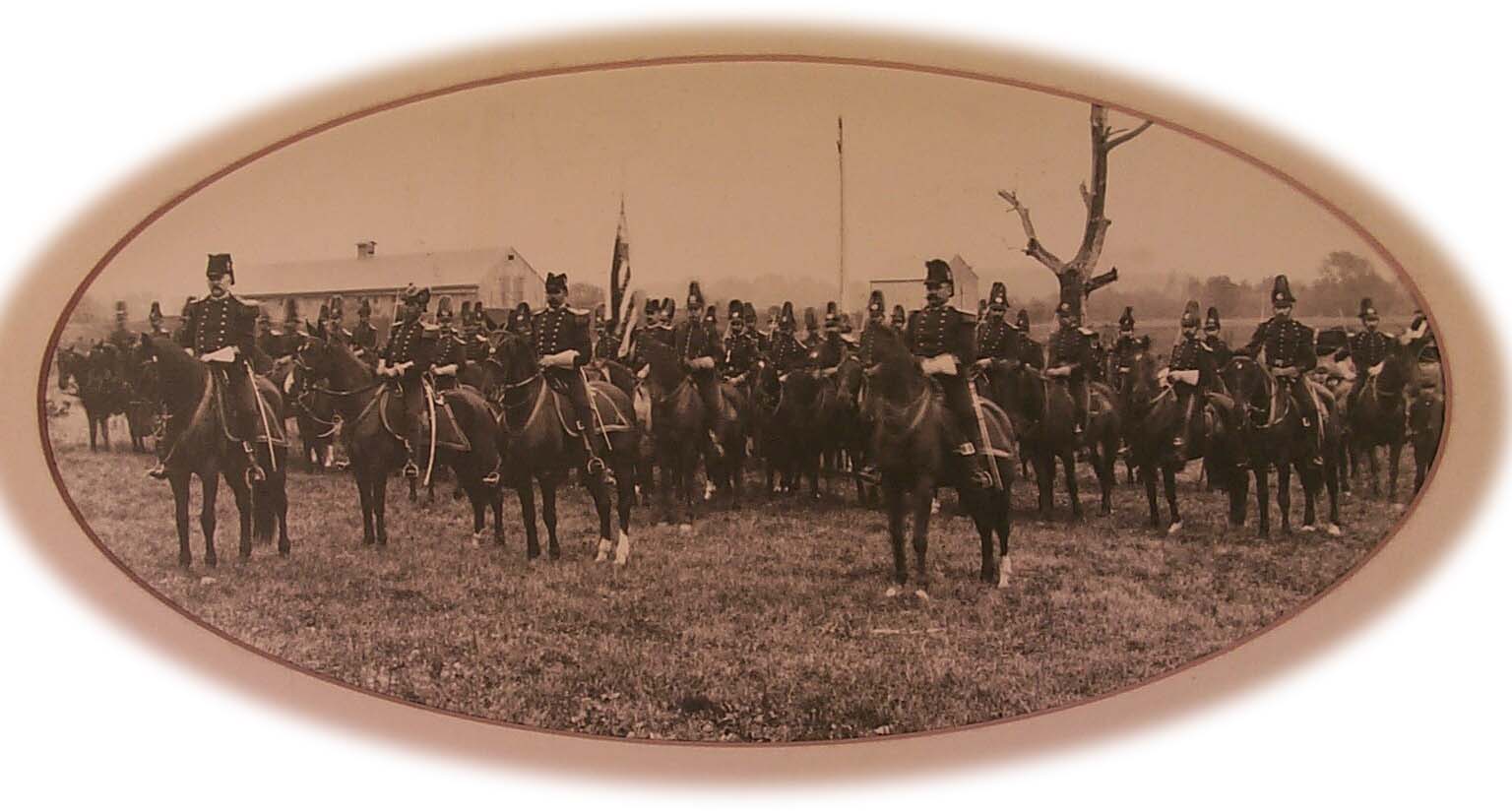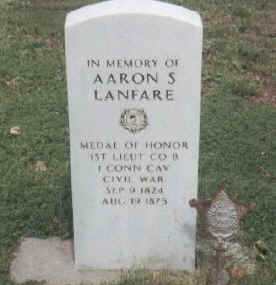History of the First Squadron Connecticut Volunteer Cavalry
|
|
During the grand uprising of loyal men which was the immediate result of the Union disaster at Bull Run, and while the infantry regiments from the Sixth to the Eleventh were forming, Major William H. Mallory of Bridgeport, who had served from the outbreak of the war, in a New York regiment known as Duryea's Zouaves, obtained from Governor Buckingham authority to recruit in Connecticut a squadron of cavalry.
|
|
Shortly after the outbreak of the Civil War, the First Connecticut Volunteer Cavalry Regiment was mustered into duty in Meriden with Major Henry Boardman of the Governor’s Horse Guard as its commandant.
|
|
|
At this early period the cavalry branch of the Union army was lamentably weak, and a plan was matured for raising a regiment of twelve companies for the regular service, by recruiting six squadrons from as many different States, it being agreed upon between the State authorities and the general government that each State should have the same credit for enlistments, and control of appointments in the companies it furnished as in the regiments of volunteers which it furnished complete. Under this arrangement the First Squadron of Connecticut Cavalry was recruited in August, 1861, Major Mallory being assisted in the work by Capt. Thos. B. Thornett and Lieut. Lucien H. Southard of Hartford, and Lieut. Marcus Coon of Waterbury. Before the end of August the squadron was mustered into the United States service. Connecticut had thus fulfilled to the letter its part of the agreement, but from the date of the acceptance of the squadron by the general government that agreement was entirely ignored by the war department, and thereafter not an officer could be appointed in these companies by the Governor of Connecticut. The squadron was almost immediately consolidated with the Second New York, otherwise known as the "Harris Light Cavalry," and Connecticut was farther defrauded by the official assignment of the entire number of officers and men to the quota of New York. One result of this was that no muster-rolls or reports from these companies were forwarded to the Adjutant-General of Connecticut during all their term of service, consequently no records are now in possession of the State from which an adequate account of their service can be obtained. |
|
|
While the regiment was en route for Washington, on September 8th, near Cockeysville, Maryland, Quartermaster-Sergeant Edwin L. Lyon and Private William A. German, both of Captain Thornett's company, met death as bravely as ever soldiers could in the field. The engineer in charge of the train, who was an ardent rebel, made a desperate attempt to bring about a disaster by running the train at such a fearful rate of speed as to throw the rear cars from the track. To foil this purpose the soldiers named attempted to check the speed by manning the brakes of the rear car, but being unable to keep their footing upon the platform were thrown from the car and instantly killed. Sergeant Lyon was a nephew of Gen. Nathaniel Lyon, who fell at Wilson's Creek, Missouri, a month later, the first Union general killed in the war. The regiment encamped on Arlington Heights, where it remained in camp of instruction until thoroughly fitted for the arduous duty it afterwards performed. It was among the very first of the volunteer cavalry regiments to prove that Union cavalry could match and overmatch the rough riders of the Confederacy. With this regiment Davies and Kilpatrick both won their first distinction as cavalry commanders; and the rapid promotions of its Connecticut men, as also the many casualties accorded them in the rosters of the two Connecticut companies, render it matter of peculiar regret that a fair and circumstantial history of their active service cannot be given. On almost every field where the cavalry of the Army of the Potomac was engaged throughout the war, the Connecticut squadron left its record of bravery, unmarred by any sign of faltering, however hotly pressed. Among the earliest in the field, it was in at the death of the rebellion. Most of its members re-enlisted as veterans, and the organization was finally mustered out of service June 23, 1865. |
|
|
Partial List of Engagements |
|
|
Falmouth, Va., April 17, 1862 |
Gettysburg, Pa., July 3, 1863 |
| Rappahannock Station, Va., August 23, 1862 | Rapidan Station, Va., Sept. 14, 1863 |
| Gainesville, Va., August 29, 1862 | Liberty Mills, Va., Sept. 22, 1863 |
| Martinsburg, Va., Sept. —, 1862 | White’s Ford, Va., Sept. 22, 1863 |
| South Mountain, Md., Sept. 14, 1862 | Brandy Station, Va., Oct. 12, 1863 |
| Catlett's Station, Va., Oct. 24, 1862 | Rapidan Station, Va., March 1, 1864 |
| Fredericksburg, Va., Dec. 11, 1862 | Dahlgren’s Raid to Richmond, Mar. 1, 1864 |
| Chancellorsville, Va., May 3, 1863 | Todd’s Tavern, Va., May 5, 1864 |
| Aldie, Va., June 17, 1863 | Ream’s Station, Va., June 30, 1864 |
| New Baltimore, Va., July 1, 1863 | |
|
Civil War Congressional Medal of Honor Recipient. Served in the Civil War as a First Lieutenant in Company B, 1st Connecticut Volunteer Cavalry. He was awarded the CMOH for his bravery at the Battle of Sailors Creek, Virginia on April 6, 1865. His citation reads simply "Capture of flag of 11th Florida Infantry (C.S.A.)". His Medal was awarded to him on May 3, 1865, which was the day he was mustered out of the Army. A pre-War merchant sailor, he returned to the Sea once the Civil War ended, becoming a successful spice merchant and trader. On a voyage to the West Indies in 1875, his ship sank, and he was lost at sea. In 1984 his descendents placed a memorial stone next to his grandfather's grave in Branford's Center Cemetery. He was one of four 1st Connecticut Cavalry soldiers to be awarded the Medal of Honor for bravery during the Civil War (the others being Private Charles H. Marsh, Captain Edwin M. Neville, and Captain Edward W. Whitaker). |
|
|
Casualties First Squadron C. V. Cavalry |
|||
|
A |
B |
Total |
|
|
Killed |
1 |
7 |
8 |
|
MIA, probably killed |
1 |
- |
1 |
|
Fatally Wounded |
1 |
2 |
3 |
|
Wounded |
- |
4 |
4 |
|
Captured |
7 |
20 |
27 |
|
Died in prison |
6 |
6 |
12 |
|
Died of disease |
8 |
8 |
16 |
|
Accidental deaths |
- |
4 |
4 |
|
Discharged disabled |
11 |
14 |
25 |
|
Unaccounted for at muster-out |
1 |
1 |
2 |
|
Total |
36 |
66 |
102 |
Editor’s Note: This is the fourth monthly installment of the history of Connecticut’s service in the Civil war, as published in the RECORD OF SERVICE OF CONNECTICUT MEN IN THE WAR OF REBELLION, 1861 TO 1865. (Transcribed by Staff Sergeant Brett W. Wilson, Administrative Assistant to the USPFO for Connecticut).



